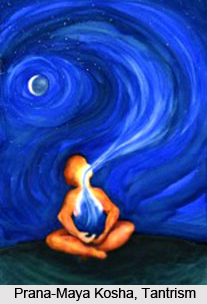 Prana Maya kosha, or the breath sheath, is a vital body, or an immaterial one in which prana, or the vital life force predominates. The Hindu concept of Prana is central to several practices and doctrines and especially so to Tantra, where it is considered a universal life-giving force. Kundalini, a form of Shakti, the female aspect of the Supreme Being, and represented as a coiled serpent at the base of the human spine, is the mother of prana in Tantrism, and is said to create prana when illumined by the supreme Atma.
Prana Maya kosha, or the breath sheath, is a vital body, or an immaterial one in which prana, or the vital life force predominates. The Hindu concept of Prana is central to several practices and doctrines and especially so to Tantra, where it is considered a universal life-giving force. Kundalini, a form of Shakti, the female aspect of the Supreme Being, and represented as a coiled serpent at the base of the human spine, is the mother of prana in Tantrism, and is said to create prana when illumined by the supreme Atma.
Vayu, or air, on entering the body divide into the pancha vayu, Prana, the life force, Udana, the ascending vayu associated with the head and higher regions of the body, apana the descending, that expels wind, excrement, semen and urine, the samana, that kindles the bodily fire and effects circulation and the vyana, ensures diffusion and division, though some texts characterise it as an attractive force deriving from the Earth element. Together, these five principal vayu effect respiration, digestion, circulation and excretion, in short, the bodily processes. Prana, udana, apana, samana and vyana are also referred to as the Pancha Vayu, or the five air deities.
The Prana Maya Kosha is hence not corporeal, composed as it is of vayu, or the element of air, and refers more to bodily processes than the physical body as such.
This article is a stub. You may contribute to it by sending your write-up to content@indianetzone.com




















